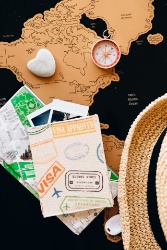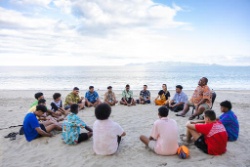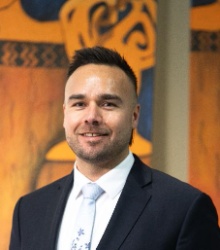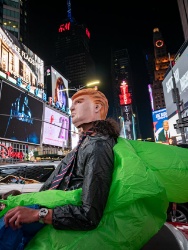Don Wiseman, RNZ Pacific senior journalist
Forty-eight years ago, a young New Zealand photographer set off on a brief solo journey into the remote Papua New Guinea Highlands.
Victoria Ginn is now in her seventies and has a gallery in the small Taranaki town of Normanby.
That trip, almost five decades ago, was the first in a series of exotic trips she undertook and resulted in a remarkable collection of photographs of the indigenous people, which she has called 'A Welcome Adventure'.
Victoria Ginn spoke with RNZ Pacific.
(This transcript has been edited for brevity and clarity.)
Don Wiseman: So when you were 23 years old, and I guess, a fairly inexperienced photographer, you took yourself off on your own into the Papua New Guinea Highlands. Why did you do that?
Victoria Ginn: Well, I probably wasn't as inexperienced as you state. I began photography when I was about 14 years old, in the 1960s, after a friend of mine realised I could take good photographs. He gave me his Leica camera, and I self taught.
I was interested in human culture and nature right from day dot really. Why I took myself into the Papua New Guinea Highlands at the age of 23, probably a yearning to connect with a deeper part of my own self and also a deeper part of the human culture, than was represented in my own modern culture, in terms of 1970s modern Melbourne, Australia, and that sort of system.
I was probably a natural photographer in terms of my yearning to use a camera as a way to connect with people. It is a form of connection, photography, or was. Nowadays it is a form of intrusion and narcissism.
But back then it was an art form, and it mesmerised me to know that you could translate a moment in reality into something that was a beautiful essence of somebody through black and white portraiture and a moment in time, where you saw an emotion or an expression or a sense of the self that was portrayed In another person.
It was never intrusive photography. When photography became fashionable in the 1970s, art photography became fashionable in the 1970s through the production of a book by Diane Arbus, and everyone had to be a photographer, sort of thing.
But photography in a way, became corrupted by wide angle lenses and people not realising the sensitivity of the other, meaning the subject, and a lot of deceitful photography happened that was calling itself art photography at that time.
DW: It's still very difficult on a number of levels to access the Papua New Guinea Highlands. But in 1977 and on your own, it would have been very, very difficult.
VG: Yes, it was. But I was an adventurer. I enjoyed the attraction of the unknown and the challenge of finding a way into an area of such remoteness in the world, where there was not a pollution of modernity, if you like, upon the peoples that I wanted to meet.
So yes, it was difficult. It was basically bussing up the Highlands into the Highlands, and then finding ways to get around. And I did have some fairly hairy encounters, not with the local people, but with imports, imported construction managers and things like people from Australia.
Papua New Guinea was only two years into its independence at that time, so there was still a very raw aspect to the confusion between what was meant to be and what was, where you have an important psyche, like the Australian mentality, wanting to civilise and develop a country, and you had the indigenous people who had stayed sane and intact and culturally together and had a very rich, beautiful culture that was kind of timeless.
DW: How did you communicate?
VG: That is an interesting one, because I discovered the art of non verbal communication, and it sounds stupid or nonsensical, but there is a way. I developed it later, when I was travelling through other remote regions of the South Pacific and Southeast Asia, particularly.
There's a way to communicate that does not require speech in terms of your tongue, and it becomes a very basic, essential, means of communication, which involves gesture, but it also involves something that is unspoken, and it is very difficult to describe that, and you connect.
It is about someone connecting to you, and you connecting to them on a level that is not cerebral, and it is not through your tongue, so not through speech. I used that method. It grew on me. It developed. I was not there long enough to become adept at that sort of thing, but I got a taste of it, and I learned how you can communicate without language.
I have spent time in a lot of different cultures using that means.
DW: This happened back in 1977, so 48 years ago. Why has it taken you so long to bring a book out?
VG: I have gone backwards, looking at my work, in a way, I'm going backwards. I am in my 70s now, and I mean, I have had other work that propelled me to do other creative essays that I was prompted to do by my own artistry, and that has come to an end.
I am no longer a photographer, so I am more a writer now, and I am looking backwards and tidying up my life, you could say.
And it is a beautiful little essay. It is a very poetic essay which portrays a form of gentleness, contrary to what is happening in Papua New Guinea today. It is a counterbalance to what is what is occurring in the Highlands today, which is now a lawless place where people have had their essential culture stripped from them by the incursion of missionaries and what have you, and mining companies and so on.
It gives voice to a portrait of a people.
DW: You've visited a number of places, as you say, remote areas around the Pacific, particularly, where does this adventure into the PNG Highlands in 1977 sit?
VG: That is a hard one. I think the last big work I did in the South Pacific and Southeast Asia was called The Spirited Earth, which was subtitled dance, myth and ritual from South Asia to the South Pacific, which was a philosophical look at the religious and spiritual forms of expression through performance art and ritual in those regions.
Mostly color photography. Back in 77 you could say this was a stepping stone to my awareness of the depth of understanding of the spiritual aspects of the human psyche within a people that were so called prehistoric and primitive. It's candid work.
It is more portraiture, portraiture in terms of face rather than form or body, which my book, The Spirited Earth, looks at the complete picture of face and form and body and environment.
This is mainly a portrait, and it's a poetic portrait which involves the poetry of the people, but also the more prosaic sort of day to day, here am I sitting in a marketplace, or here am I pulling my bow and arrow, carrying my grasses from the fields and so on.
It is more a documentary portrait than an artistic portrait, but it contains artistry, of course.



 U.S. Department Of State: The United States Withdraws From The United Nations Educational, Scientific And Cultural Organization (UNESCO)
U.S. Department Of State: The United States Withdraws From The United Nations Educational, Scientific And Cultural Organization (UNESCO) Henley and Partners: Asian Nations Dominate Passport Power Ranking As US And UK Continue To Decline
Henley and Partners: Asian Nations Dominate Passport Power Ranking As US And UK Continue To Decline UNICEF Pacific: 14 Adolescent Representatives From Across The Pacific Call Themselves The Young Pasifika Wayfinders
UNICEF Pacific: 14 Adolescent Representatives From Across The Pacific Call Themselves The Young Pasifika Wayfinders UN News: ‘You Have To Be Able To Rule Your Life’ - The Care Revolution In Latin America
UN News: ‘You Have To Be Able To Rule Your Life’ - The Care Revolution In Latin America NZ Harkness Fellowship Trust: Championing Innovation In Māori Economic Development - Jacob (Hākopa) Ashdown Named 2025 Harkness Fellow
NZ Harkness Fellowship Trust: Championing Innovation In Māori Economic Development - Jacob (Hākopa) Ashdown Named 2025 Harkness Fellow ICHRP: Trump 20% Tariff On Philippine Exports Hits Workers, Farmers Hardest
ICHRP: Trump 20% Tariff On Philippine Exports Hits Workers, Farmers Hardest